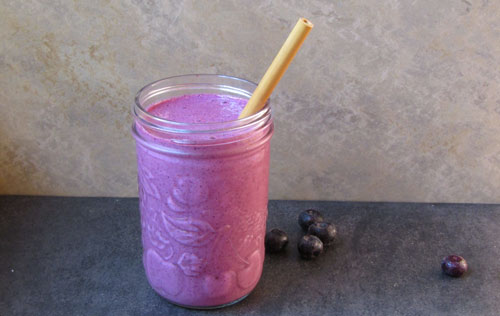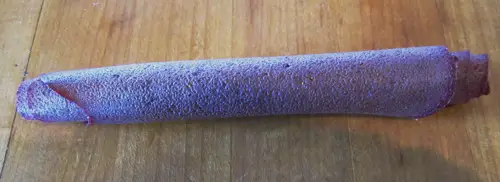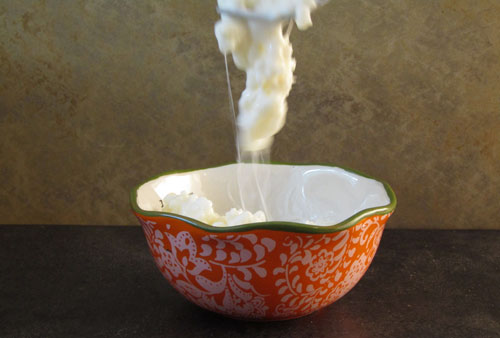This post contains affiliate links.
Once your kefir grains are activated they will start to get bigger and softer as they get hydrated from the milk they are fermenting. You may start to notice a slimy coating forming around the grains as you strain them out of the milk.
Kefir grains become slimy when microorganisms found in the grain begin to produce a biofilm around the grains. It appears in varying amounts once the grains have been fully hydrated and is a sign of healthy grains. If the kefir is overly slimy, changes in environment can slow its production.
This biofilm acts as a protectant from invading bacteria. It is anti-microbial and anti-fungal making it an effective barrier against environmental pathogens. It is also one of the materials used in the construction of kefir grains. Lb. kefiri is involved in the production of a exopolysaccharide which is one of the materials used in production of the kefir grain. The presence of this biofilm is a sign of a healthy kefir grain and kefir grain growth.
Is it okay to eat kefir made with slimy kefir grains?
Kefir made with slimy grains may not be as appetizing as fresh slightly fizzy kefir but it will not harm you. A slimy consistency of kefir indicates that there is a high amount of biofilm produced by the kefir grains which has been dispersed into the kefir.
This biofilm will adhere to most surfaces and provide protection from pathogenic microorganisms. Much like the mucus in our digestive tracks and lungs protect us from sickness by capturing and destroying foreign objects.
It also may also help the probiotic species which are active in the kefir to get past the high acidity of the stomach acting as a buffer and therefor increasing their survival rate.
What the slimy stuff is made of
The slimy stuff (biofilm) is made up of mostly polysaccharides which are several sugar molecules linked together to make one long chain. Polysaccharides are what makes up sugars and carbohydrates and can be different shapes and sizes.
Depending on the length and shape of the chain of sugar molecules they can be anything like starch, lactose or white sugar. The polysaccharides which make up the biofilm come mostly from the lactose found in the milk once it has been broken down into smaller pieces. They store concentrated energy, help with cellular communication and can be made into a variety of structures.
How to alter the amount of biofilm produced by kefir grains
The cultures which are present in the kefir grain are varied depending on the source of the grains, its current environment and its food source. There have been up to 50-60 different culture species found in a single kefir grain.
Each of these species react differently to variations in environment and perform different roles in the kefir grain community. Yeasts such as Lb. kefiranofaciens and others produce a biofilm which is thought to be crystalized further by Lb. kefiri in the formation of the grains.
Some lactic acid bacteria act as biofilm inhibitors which reduce the amount of biofilm produced. They may prevent some yeasts from making the biofilm or they may use some of the biofilm as food, converting it into even smaller polysaccharides.
This push and shove relationship can make it difficult to produce a consistent kefir at home and sometimes the kefir may be slimier than expected.
There are several factors which alter the consistency of your kefir such as temperature, fermentation time, condition of the grains and the milk it uses for food. For an in depth method to adjust the conditions of kefir fermentation read Five Reasons Kefir Separates: Plus The Real One.
Briefly if you want to reduce the amount of biofilm produced you need to increase the action of the lactic acid bacteria and reduce the yeast activity. Since lactic acid bacteria are less temperature sensitive if you reduce the temperature the kefir is fermented this may reduce the slimy texture.
On the other end of the scale you may have noticed if you have stored extra kefir grains in the fridge that the slimy texture of the grains is higher after about a week of storage. This is because even though the fermentation is cooled it still continues to ferment the milk it is stored in. The yeast in the grains will continue to convert the lactose into shorter chain polysaccharides while the lactic acid bacteria produce lactic acid. This environment when left alone for a week or so will slowly acidify the milk and produce abundant amounts of biofilm.
Some people believe that the kefir grains produce more biofilm in cooler temperatures but this is untrue. Kefir cultures are more active in warmer temperatures then cooler ones so they will produce more biofilm then when cool.
It may take a few days for the grains to readjust to its new state so be patient. If the kefir is still too slimy for you then shorten the fermentation time or reduce the amount of grains to milk ratio.
How to reduce the slimy texture of kefir
Sometimes the biofilm on hte grains can get excessive and start to effect the texture of hte kefir itself. If you find yourself in this situation you may want to reduce the slimy texture of your kefir which is already made.
To do that try adding some fresh milk to the jar and let it ferment for 12-24 hours. Since the cultures are still present in the keifr the milk will be converted into kefir but without the added slimy texture from the excessive amount found on the frains.
Lb. kefiri the yeast which is thought to be key in the production of the biofilm grows quickly in warm temperatures so if you reduce the ambient temperature where you ferment your kefir the yeast will produce less biofilm overall and the kefir will have better texture. The lower the temperature in the room the slower the action of the yeasts which produce the main components of the biofilm.
What to do with slimy kefir
Slimy kefir has not gone off. It still has value and can be used for a number of things even if you don’t want to drink it like you would non-slimy kefir. In fact some of the properties of kefir with a high amount of biofilm is useful in a variety of recipes.
Smoothies

Smoothies are an ideal way to use kefir which is high in biofilm. The stickiness of the biofilm helps the smoothie remain uniform.
The usual method to prevent a smoothie from separating is to use bananas or other soft fruits which have a creamy nature. The problem with this is the high sugar concentration of these fruits can make the smoothie hard to digest, higher in calories and add flavors which some may not like.
Kefir which has a high amount of biofilm in it tastes essentially like kefir which has a low amount of biofilm. This means that the use of kefir with a high biofilm content will not change the flavor substantially but the biofilm will help the smoothie from separating in the glass.
Dressings
Creamy salad dressings have the same problem as smoothies when made at home. This is because when they are made at home emulsifiers like gaur gum are not added. This can lead to your salad dressing separating into oil on top and water based ingredients on the bottom.
With the addition of kefir with a high amount of biofilm in it the dressing will stay combined longer. It will also help the dressing stick to the contents of the salad rather than sinking to the bottom of the bowl.
Fruit leather

Kefir which is stringy and holds together is ideal for making a fermented fruit leather. It provides an interesting tangy flavor to the fruit leather, helps it to last longer and helps to keep the leather together.
It can be made with any type of fruit and is easy to make if you have access to a dehydrator.
Granola
Granola is usually a collection of oatmeal, dried fruits, nuts and seeds all held together with some type of syrup. This makes granola full of vitamins and minerals and good for you proteins but with the added sugar which holds it together the benefits are severely reduced.
Granola which is held together with kefir on the other hand is lower in sugar content and if you dehydrate the granola rather than cooking it to remove the excess liquid the probiotics in the kefir remain intact along with the heat sensitive vitamins in the fruit, nuts and seeds.
With the addition of the kefir the granola will store for a long time due to the slightly acidic nature and the active cultures which remain.
Gravy
Gravy is usually made by adding some form of gluten containing starch to broiler pan drippings and then heated to form long strands of gluten which thicken the gravy.
Of course the problem with this is gluten is hard to digest and for some is not tolerated well.
Instead if you make gravy with kefir with a high biofilm content it can thicken the gravy without gluten and at the same time make the meal it is served with digest faster and better.
Baking
Kefir which is highly slimy has a high concentration of active yeasts in it. It is these yeasts which eat the carbohydrates in the flour and make CO2 gas which causes the baking to rise. This can be used as a fast way to make sourdough bread if you don’t have time or inclination to start a sourdough starter.
It can also be used in biscuits or other recipes using soda or baking powder. The acid produced by the lactic acid bacteria react with the basic baking soda or baking powder and provide additional rising power making the recipe fluffier.


